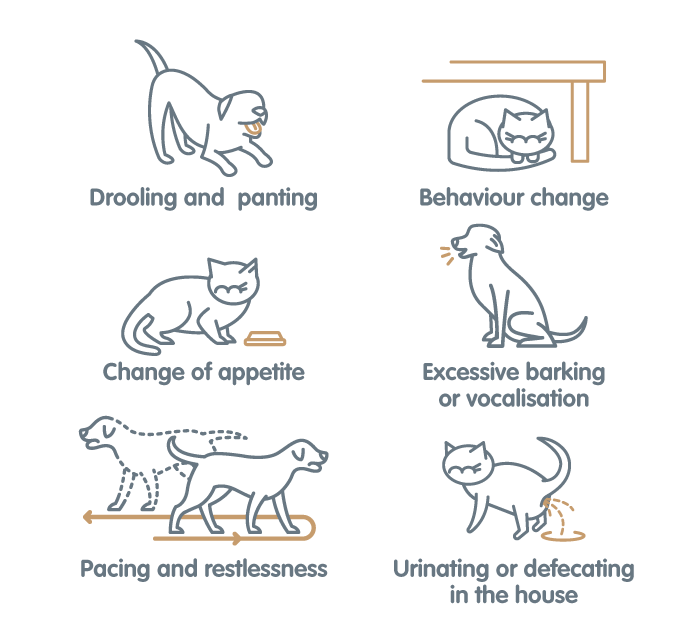Signs of Anxiety in Domestic Pets
Changes in routine can be a stressful situation for everyone, including our pets, which can result in anxiety and overall discomfort. There are a number of things that can trigger stress or anxiety in your pet, including holiday events, unfamiliar people, new pets in your household, loud noises, and even travelling in the car. Or maybe your pet is just naturally anxious, this can be common as it can be with humans. Regardless of the situation, there are signs you can see which may tell you your pet is anxious, and there are ways that you can help.
Symptoms of Pet Anxiety
It can be distressing to see your pet in distress, but there are ways you can help put them at ease, and the first step is recognising the signs that they’re uncomfortable, this will vary depending on what type of pet you have, but some common signs of anxiety in pets can include:
- Drooling or panting.
- Changes in behaviour (such as hiding or being less interested in toys or affection).
- Changes in appetite (eating or drinking more or less than usual).
- Excessive vocalising (such as whimpering, crying, etc.).
- Pacing or restlessness.
- Urinating or defecating in the house or outside their designated area.
If you notice any of these signs in your pet, then it could be a sign of anxiety, and the first step to making them feel more comfortable is to find the root cause so you can begin to find ways to help.

Relieving Anxiety for Pets
There are numerous ways you can help soothe your pet if they are feeling stressed or anxious without the need for medical intervention. What will work will vary between individuals and the type of pet you have, so don’t be discouraged if your first attempts at calming them don’t have the desired effect.
Some common ways to help treat your pet’s anxiety include:
- Remove triggers - If you know what causes your pet’s anxiety, removing these triggers where possible will help ease their worries or stress.
- Distracting your pet - if you can’t remove the trigger try to distract your pet with toys or having the music on, anything to keep them occupied and not paying attention to the trigger.
- Medication - For some animals, there are pet medications designed to calm and destress your pet, these can come in diffusers, sprays tablets and more. These are more common for dogs, cats and horses.
Of course, treating your pet’s anxiety does depend on the type of pet you may have. Below are the sections for each specific pet, their anxiety and how to treat it:
Anxiety In Dogs
If you’re dog has anxiety, this can be because of a trigger such as new people or a new environment, moving house, stressful situations, loud noises or more. Dog anxiety is most prevalent as separation anxiety and the fear of being left. Some signs of anxiety in dogs include:
- Aggression or Destructive behaviour
- Drooling or Panting
- Pacing around
- Excessive barking
- Urinating or defecating in the house
- Depression, fatigue or general low mood
- Change in appetite
How To Help Anxiety In Dogs
If you know what triggers your dog’s anxiety, the first thing you should do is take away the trigger. If you can’t, try to distract your furry friend with dog toys, or boredom breakers such as KONG. Other ways you can calm your anxious dog are through exercise, physical contact and comforting them.
If your dog is suffering from separation anxiety a good way to help ease their worries is to give your dog a special treat or boredom breaker when you leave to keep them occupied. Or to leave them with something with your scent to comfort them while you’re gone. Also, to get them used to you being gone try to go for short periods of time and then increase the length of time slowly.
Another way you can treat dog anxiety is through a range of medications. From dog calmers such as calming sprays, liquids, toys and collars. Or you can try dog anxiety medication such as tablets, pheromone diffusers and more. These will help to calm your dog and can be given before the trigger, or if your dog is naturally anxious, they can be given to calm them regularly.
Anxiety In Cats
Cat anxiety can cause a change in their reactions as well are their behaviour. The most obvious signs are if your cat is acting differently than its normal self, such as hiding more within the house or acting out such as causing destruction. Another way you can spot an anxious cat is through increased heart and breathing rates, panting, trembling or shaking, as well as excessive vocalisation such as hissing, meowing and more.
Anxiety in cats can again be triggered by an unfamiliar or stressful situation, a traumatic experience or even if your cat is in pain or ill.
How To Treat A Cat With Anxiety
If you know what is causing your cat to have anxiety, a good rule of thumb is to try and remove the trigger or avoid it. If this isn’t possible, try to make gradual changes and introduce your cat to the new environment slowly. Make sure they know that there is nothing to be afraid of and comfort them along the way. Cats also need ‘safe spaces’, so make sure that you provide them with some places where they can go and hide if they need to seek comfort.
If your cat has separation anxiety a good way to help them is it provide them with toys to distract them. You can even use cat toys infused with catnip, which naturally calms and distracts your cat. Also, try providing them with a familiar scent or start with shorter absences first to get them used to being left alone over time.
If your cat is still struggling with anxiety, there are other ways you can help, including using cat calmers such as sprays and diffusers or trying cat anxiety medication, including tablets and liquids. These include calming hormones to regulate your cat’s mood and anxiety.
Pheromone Diffusers for Cats and Dogs
If the previous options don’t work, you can always employ the use of pheromone products to help soothe your pet. These products range from diffusers, collars and sprays that release pheromones like those naturally released by your pet when they are feeling happy and content. Your pet will then react to these pheromones and feel more at ease in their new environment. This is particularly useful when you’re introducing a new pet, travelling with your pet in the car, or moving to a new home.
Cats and dogs don’t respond to the same pheromones, so it’s important to get the correct product.
Anxiety In Horses
Like other pets and animals, horses can also get stressed. Whether you’ve got a pet horse or train your horse for competing, your horse can easily get anxious when travelling, competing or learning. Your horse can also become easily spooked or stressed out by unknown loud noises or new environments. Horses with anxiety may show the following symptoms:
- Excessive chewing or grinding teeth
- Weight loss or change in appetite
- Spooking easily or shaking
- Pacing, rearing or bolting around
- Sweating or suffering from illnesses or diarrhoea
How To Help An Anxious Horse
Some good ways that you can help reduce stress and anxiety in horses include helping to keep a consistent routine and giving them plenty of comfort and relaxation time when they become stressed. If your horse becomes anxious when travelling or in an unknown situation, a good way to help calm them down is through exercise, comfort, providing plenty of hay or water, and having plenty of treats to give them.
Of course, removing the trigger is the best way to reduce anxiety in horses, but sometimes this isn’t always possible. To help aid in treating horse anxiety, there are plenty of horse calmers that you can try. From calming diffusers, liquids, and sprays, as well as horse anxiety medication such as pastes or powder to put in with their food. These are especially helpful if your horse is naturally anxious or struggles with stress before travelling or competing.
Anxiety In Small Animals
If you’ve got a smaller pet such as a bird, hamster or another type of rodent or small animal, it can be common for them to get stressed out and show signs of anxiety. But, there are ways that you can help soothe your pet’s anxiety. Of course, treating your pet’s anxiety does depend on the type of pet you may have. Below are the sections for each specific pet, their anxiety and how to treat it:
Anxiety in Birds
Birds can become stressed out and anxious in stressful or unknown situations and if your bird is anxious it can actually startle so severely they may hurt themselves. Signs your bird has anxiety include flying into obstacles, biting, hissing, and excessive distress calls or screaming as well as a decreased appetite. Anxious birds may also have physical changes such as tremoring, feather picking, self-mutilation and unstereotypical behaviour.
If your bird is suddenly stressed there are ways that you can help. To treat an anxious bird first try to remove the trigger if you know what it is. Otherwise, approach your bird and move around slowly, moving fast may agitate your bird further. Try to comfort your bird and provide some stimulation if you can, such as a favourite toy or food. Another way to calm your bird is to give them some out-of-cage time to destress and relax. Whatever you do, just don’t yell and scream, as this can frighten your bird even more. Try to stay calm and comfort your stressed friend.
Anxiety in Rabbits
Anxiety can be a common problem among pet rabbits because their wild instinct is to be alert for predators and dangers. So, even though your bunny is in a safe environment they can become stressed or anxious even when there isn’t a trigger such as unknown or stressful situations.
Signs of rabbits with anxiety include appearing nervous such as freezing when approached, hunched up with their ears flat, being jumpy and watchful or even unusually aggressive. Other symptoms of stress in rabbits include lethargy, lack of appetite, easily agitated and excessive grooming.
Ways that you can help destress a bunny include being calm and quiet around them, avoiding grabbing and holding your rabbit, and giving them plenty of rabbit food, treats, water and toys. Make sure they have a large enough enclosure so they aren’t too overwhelmed with a lack of space and that they have safe places to hide. As well, rabbits are social animals so having a pair is best so they have company. If you’ve got a new bunny, try to give your new friend some time to trust you and keep a regular routine so they know what’s going on.
Anxiety in Hamsters and Guinea Pigs
Hamsters and guinea pigs display anxiety in similar ways, from hiding or avoidance behaviours like spending time in nests, bedding or spending time near walls. Other ways you can tell your hamster is anxious or your guinea pig is stressed is through aggressive behaviour such as biting, lack of appetite, or freezing in your presence. Reasons why your pet may be anxious are because of a situation, loud noise, or possibly a new or unfamiliar environment.
Ways that you can help your hamster or guinea pig with anxiety is by making sure that you have the right-sized cage. Make sure they have enough space so they don’t feel too crowded or too overwhelmed, and provide hideout, bedding hay, or places where they know it’s safe. Be calm around your pet and use a soft voice so you don’t scare them. Another good way to help your guinea pig or hamster with anxiety is entertaining them, playing with them, but also making sure they have enough to keep themselves occupied within their cages.
If you’ve got a guinea pig, make sure that you never keep a guinea pig on its own. Guinea pigs should always be kept in pairs as this will help provide companionship all the time, as a single guinea pig can become very lonely and the stress can impact their health. Just make sure you introduce the new family member with ease so both parties know it’s safe.
Anxiety in Mice and Rats
If you’ve got a pet mouse or a pet rat, these animals are naturally explorative and inquisitive. So they aren’t usually the type of animal to become anxious, but it can happen with loud noises, bright lights, elevated areas, being handled, or in stressful situations Your anxious rat or mouse may exhibit symptoms including increased vigilance, freezing or hypoactivity, elevated heart rate and lack of appetite.
To help destress your mouse or soothe your rat’s anxiety, try to give them some time to calm down and relax. If you want to comfort them, be gentle and quiet, and never squeeze them or hold them by the tail. Also, they can sense stress and fear, so avoid touching or holding them if you are in a bad mood as it will only make them more uncomfortable. Rats are also best in pairs so having a buddy would be better to soothe your rat’s anxiety. Also, make sure to give them plenty of room and things to do in their cage, as this will help to distract them as they love to explore.
Anxiety In Ferrets
Ferrets, like any of the animals above, can become anxious from stressful situations or triggers. Signs your ferret may be anxious include acting confused or running around frantically, lethargy or not wanting to play, refusing food, being grumpy or agitated, and just not their usual selves.
Ways that you can comfort and calm a ferret down include playing with them and giving them a favourite toy, blanket or other safety net. You can also try to gently sway them back and forth when holding them, this relaxes them and they usually enjoy this. Ferrets can also get separation anxiety so if your ferret struggles with this, try to give them a piece of clothing or something with your scent to comfort them when you’re not around.
Anxiety In Fish
A common pet that most people may not think gets stressed or anxious is fish. But, fish can become easily spooked and stressed out, which can even be harmful to their health. They can become stressed or anxious in a range of situations including:
- Environmental - new tank, water quality, hiding places, vibrations or tapping on the glass, overcrowding
- Social - breeding, predator/prey interactions, living with other fish that attack them (i.e. Japanese Fighter Fish will attack and potentially kill other fish in the tank - this causes stress to the fish)
- Handling/Transport - moving and cleaning the tank, placing them in a new tank
- Nutritional - too much food or lack of food, malnutrition
Fish that are stressed or anxious may show this through strange swimming patterns such as swimming frantically, crashing into the tank or into things within the tank, rubbing themselves on gravel, locking their fins at the side, swimming away from other fish or hiding.
Ways that you can help an anxious fish are to make sure the water levels are right, change it frequently to keep nitrate and ammonia levels low, as well as cleaning the tank. Also, make sure the water temperature is correct for the fish type to prevent stressful fluctuations. Make sure there is plenty of space within the tank for the fish and that you pair the right fish together to create a balanced environment, as well as making sure there is enough fish food to go around.
Prescription Medication for Pets with Anxiety
If your pet is naturally anxious, or they don’t respond to any other ways you’ve tried to calm them, then it may be necessary to try them on prescription calming aids. These products can help put your pet at ease in ordinary day-to-day scenarios, or as one-time prescriptions which can help with long car journeys (if you’re moving particularly far or even abroad). These kinds of anxiety treatments aren’t available for all kinds of pets and can only be bought with a valid prescription from your vet. ,So, if you’ve tried all the possible ways to destress your pet, try going to your vet for professional advice, and then you can buy the suggested pet prescriptions with us.
Pet anxiety can be distressing, but once you recognise the signs of stress in your pet, you can begin to find ways to help them feel more at ease with whatever life throws at them. If you’d like to learn more about any of the products mentioned, or ways you can help with your pet’s anxiety, get in touch with us. We’re here to help.
This post is an opinion and should only be used as a guide. You should discuss any change to your pet’s care or lifestyle thoroughly with your vet before starting any program or treatment.













































